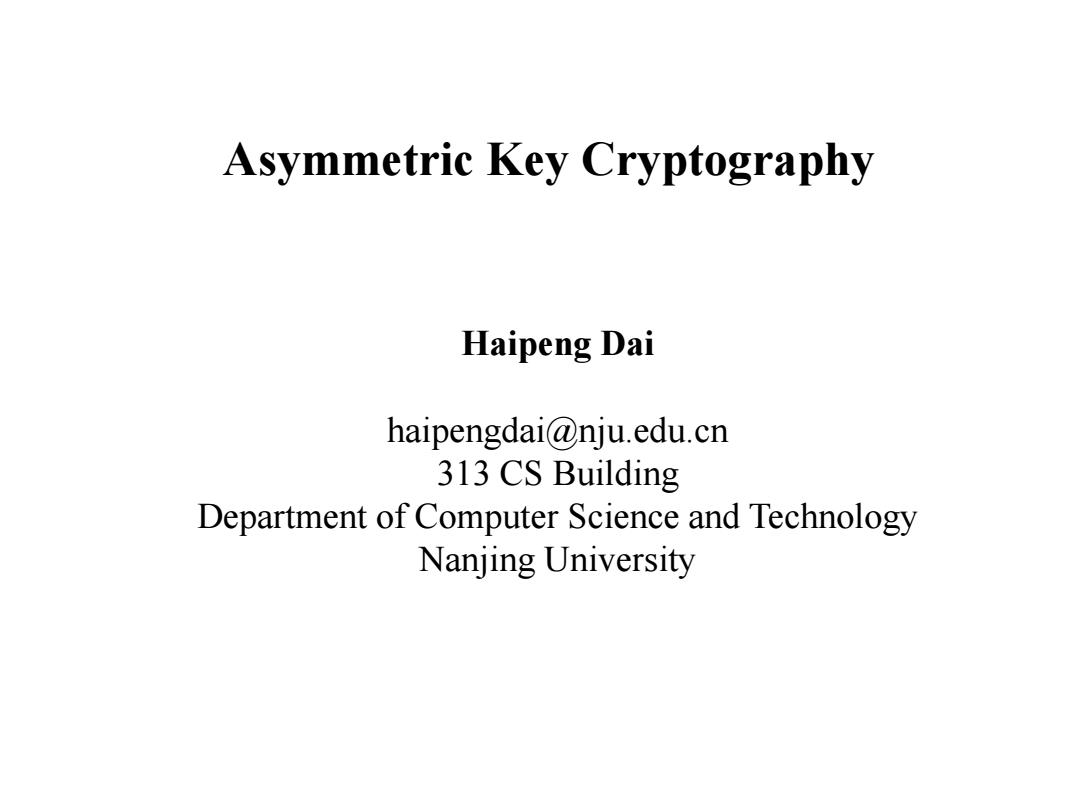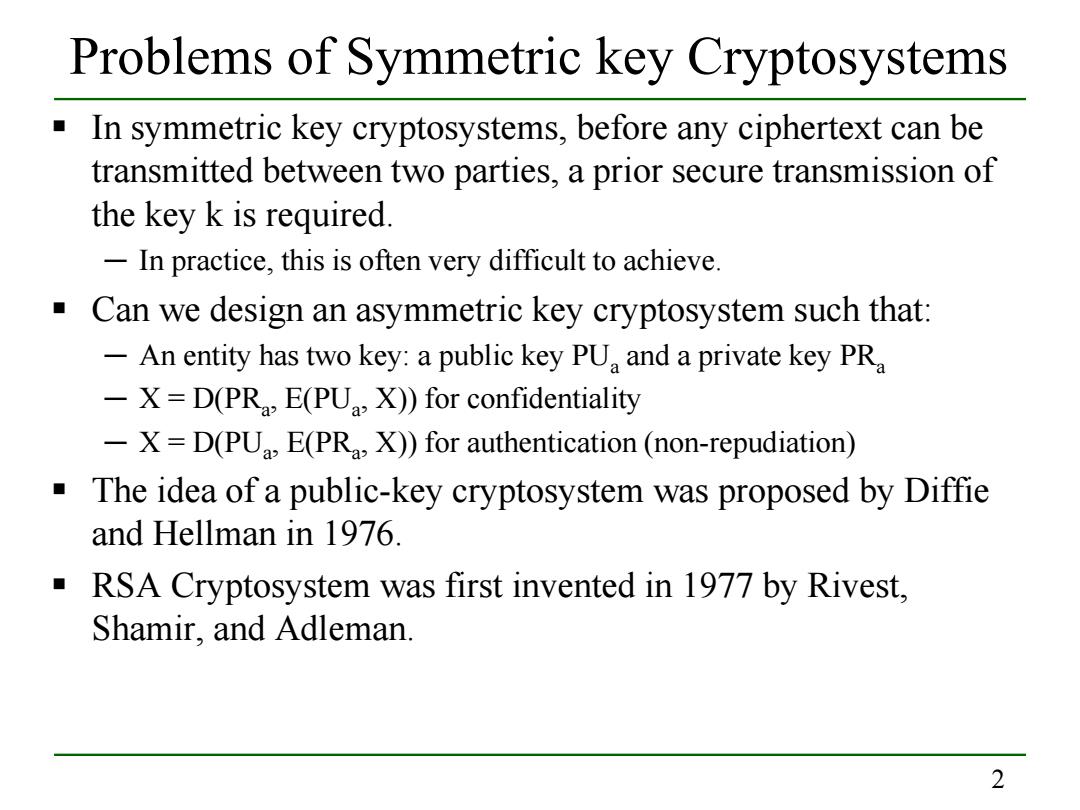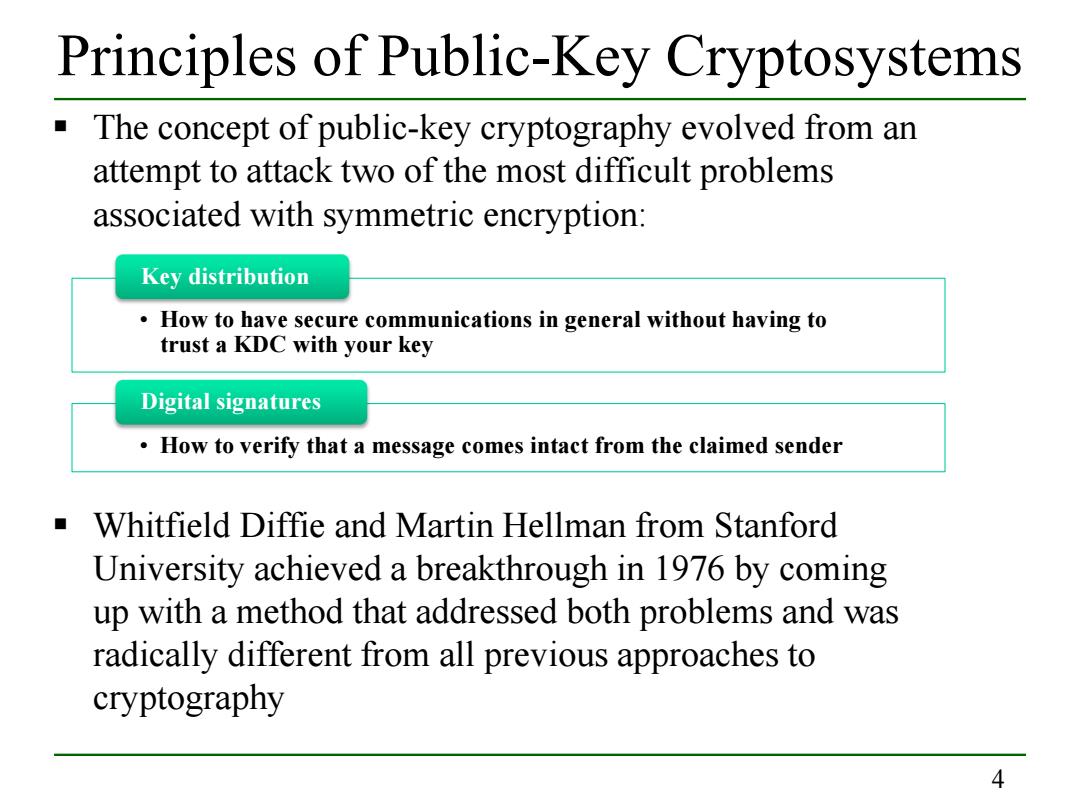
Asymmetric Key Cryptography Haipeng Dai haipengdai@nju.edu.cn 313 CS Building Department of Computer Science and Technology Nanjing University
Asymmetric Key Cryptography Haipeng Dai haipengdai@nju.edu.cn 313 CS Building Department of Computer Science and Technology Nanjing University

Problems of Symmetric key Cryptosystems In symmetric key cryptosystems,before any ciphertext can be transmitted between two parties,a prior secure transmission of the key k is required. -In practice,this is often very difficult to achieve. Can we design an asymmetric key cryptosystem such that: -An entity has two key:a public key PUa and a private key PRa -X=D(PR,E(PU,X))for confidentiality -X=D(PUa E(PRa,X))for authentication(non-repudiation) The idea of a public-key cryptosystem was proposed by Diffie and Hellman in 1976. RSA Cryptosystem was first invented in 1977 by Rivest, Shamir,and Adleman. 2
2 Problems of Symmetric key Cryptosystems In symmetric key cryptosystems, before any ciphertext can be transmitted between two parties, a prior secure transmission of the key k is required. ─ In practice, this is often very difficult to achieve. Can we design an asymmetric key cryptosystem such that: ─ An entity has two key: a public key PUa and a private key PRa ─ X = D(PRa, E(PUa, X)) for confidentiality ─ X = D(PUa, E(PRa, X)) for authentication (non-repudiation) The idea of a public-key cryptosystem was proposed by Diffie and Hellman in 1976. RSA Cryptosystem was first invented in 1977 by Rivest, Shamir, and Adleman

Misconceptions Concerning Public-Key Encryption Public-key encryption is more secure from cryptanalysis than symmetric encryption Public-key encryption is a general-purpose technique that has made symmetric encryption obsolete There is a feeling that key distribution is trivial when using public-key encryption,compared to the cumbersome handshaking involved with key distribution centers for symmetric encryption 3
3 Misconceptions Concerning Public-Key Encryption Public-key encryption is more secure from cryptanalysis than symmetric encryption Public-key encryption is a general-purpose technique that has made symmetric encryption obsolete There is a feeling that key distribution is trivial when using public-key encryption, compared to the cumbersome handshaking involved with key distribution centers for symmetric encryption

Principles of Public-Key Cryptosystems The concept of public-key cryptography evolved from an attempt to attack two of the most difficult problems associated with symmetric encryption: Key distribution How to have secure communications in general without having to trust a KDC with your key Digital signatures How to verify that a message comes intact from the claimed sender Whitfield Diffie and Martin Hellman from Stanford University achieved a breakthrough in 1976 by coming up with a method that addressed both problems and was radically different from all previous approaches to cryptography 4
4 The concept of public-key cryptography evolved from an attempt to attack two of the most difficult problems associated with symmetric encryption: Whitfield Diffie and Martin Hellman from Stanford University achieved a breakthrough in 1976 by coming up with a method that addressed both problems and was radically different from all previous approaches to cryptography Principles of Public-Key Cryptosystems • How to have secure communications in general without having to trust a KDC with your key Key distribution • How to verify that a message comes intact from the claimed sender Digital signatures

Public-key Cryptography (1/2) Encryption Bobs's public key ring Joy Mike Alice Alice's public Alice 's private key key Transmitted ciphertext Plaintext Plaintext input Encryption algorithm Decryption algorithm (e.g.,RSA) output (reverse of encryption algorithm) (a)Encryption 5
5 Public-key Cryptography (1/2) Encryption